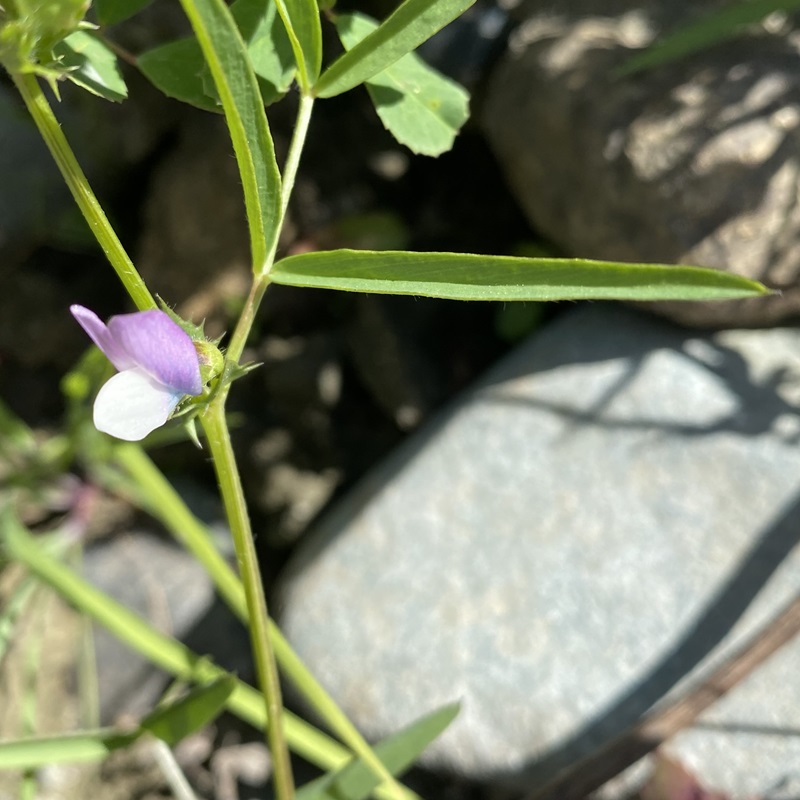Βίκος ο ξενικός
Etymology of Vicia peregrina: The Latin name of the genus, "Vicia", meaning "binder", derives from Proto-Italic "wikia", which in turn originates other from Proto-Indo-European "weyk-", meaning "to curve, bend" or from Proto-Indo-European "wehy- ". The name "binder" alludes to the activity of the tendrils. "Bithynica" is derived from Bithynia, an ancient region in northwestern Anatolia (modern-day Turkey). The name indicates that the plant was either first discovered, described, or commonly found in that region. So, bithynica essentially means "from Bithynia".
At least 26 Vicia species and subspecies/kinds have so far been identified in the wild Cypriot habitat, of which two appear exclusively in occupied northern Cyprus.
This species is encountered all around lowland Cyprus, except for Nicosia and the surrounding areas, up to an altitude of 450 metres. Its flowering period in Cyprus is usually between March and April.
Habitat
Vicia bithynica thrives in a variety of habitats, particularly in dry grasslands, scrublands, and woodland edges. It is commonly found in Mediterranean environments, growing in maquis and garrigue shrublands, where it benefits from partial shade and support from surrounding vegetation. It prefers calcareous, sandy, or rocky soils and is often seen climbing on shrubs or grasses in open meadows and forest margins. Additionally, it can be found in coastal areas and rocky slopes, where it adapts to well-drained soils and moderate drought conditions, making it well-suited to warm, temperate climates.
How to identify Vicia bithynica:
Vicia bithynica has similar flowers to Vicia peregrina, and this creates confusion. These two species, though, have some very vivid differences that assist in their recognition.
Leaf Morphology of Vicia bithynica and Vicia peregrina
The leaves of Vicia bithynica and Vicia peregrina are pinnately compound, but they differ in the number of leaflet pairs, shape, size, and hair coverage. In Vicia bithynica, the number of leaflet pairs can vary widely, ranging from 1 to 6 pairs, though 2–4 pairs are most common. The leaflets are typically elliptic, oblong, or broadly lanceolate, often with a slightly rounded base. Their length ranges from 10 to 35 mm, and their width varies between 4 to 12 mm, depending on environmental conditions. In contrast, Vicia peregrina generally has more leaflet pairs, ranging from 2 to 10 pairs, with 5–7 pairs being the most common. The leaflets are narrower and more linear to lanceolate, giving the plant a more delicate appearance. Their length varies between 5 to 25 mm, and their width is usually 1.5 to 6 mm, making them considerably more slender than those of Vicia bithynica.
The terminal tendril in Vicia bithynica is usually present, helping the plant climb, but in some cases, it may be reduced or absent, especially in plants growing without support. In Vicia peregrina, tendrils are also present but may be less developed or weaker, leading the plant to have a more sprawling growth habit. The stipules (small leaf-like structures at the base of the leaf stalk) in Vicia bithynica are semi-sagittate (arrowhead-shaped) and relatively prominent. In Vicia peregrina, stipules are generally smaller and less pronounced.
Hair coverage on the leaves and leaflets also varies between the two species. In Vicia bithynica, the leaflets are typically glabrous (smooth and hairless), but some individuals can have a fine pubescence (soft hairs) on the underside of the leaflets. In contrast, Vicia peregrina is more likely to have a fine layer of pubescence on both sides of the leaflet, making it slightly rougher to the touch. This difference in hairiness can be useful in distinguishing between the two species in the field.
In summary, Vicia bithynica has fewer, broader, and often smoother leaflets, while Vicia peregrina has more numerous, narrower, and often hairier leaflets. These differences, along with variations in tendril strength and stipule size, provide clear anatomical distinctions between the two species.
Flower Morphology of Vicia bithynica and Vicia peregrina
The flowers of Vicia bithynica and Vicia peregrina share a typical papilionaceous (pea-like) structure, but they differ in size, color, arrangement, and floral parts, including the pedicels, calyx, and corolla.
In Vicia bithynica, the flowers are typically larger, measuring 10–22 mm in length, whereas in Vicia peregrina, they are usually smaller, ranging from 8–15 mm. The corolla color in Vicia bithynica varies from pale purple to pinkish-violet, often with darker purple veins running through the petals. In contrast, Vicia peregrina has bluish to deep violet flowers, sometimes appearing more intensely colored than those of Vicia bithynica.
The pedicels (the stalks supporting individual flowers) are shorter and more robust in Vicia bithynica, typically ranging from 2 to 6 mm. In Vicia peregrina, the pedicels are longer and more slender, often measuring 5–12 mm, giving the flowers a more spaced-out appearance within the inflorescence. The flowers of Vicia bithynica are usually solitary or appear in pairs, whereas Vicia peregrina often has inflorescences containing 2–5 flowers per raceme, though some specimens may have a solitary flower or more than 5.
The calyx in Vicia bithynica is tubular or slightly campanulate (bell-shaped), with unequal teeth, where the upper two teeth are often shorter and broader, and the lower three teeth are longer and narrower. It is typically glabrous or sparsely hairy. In Vicia peregrina, the calyx is more elongated, with narrower and more equal-sized teeth, and it is often more densely hairy, giving it a slightly fuzzy appearance.
The standard petal (the large upper petal) in Vicia bithynica is broader and more rounded, often slightly notched at the tip, while in Vicia peregrina, it is narrower and more elongated. The wings and keel petals (the lateral and lower petals that enclose the reproductive organs) in Vicia bithynica are well-developed and proportionally large, whereas in Vicia peregrina, they are smaller and more delicate in comparison to the standard petal.
Overall, Vicia bithynica has larger, more widely spaced, and pinkish-purple flowers, often appearing solitary or in pairs on shorter pedicels, while Vicia peregrina has smaller, bluish-violet flowers that are more clustered, with longer, slender pedicels and a generally hairier calyx. These floral differences, along with variations in size and color, make it possible to distinguish between the two species in their natural habitats.

